A sport for everybody
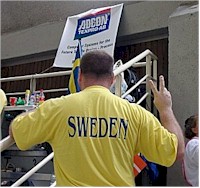 Agility
was brought to Sweden by Marie Hansson in the late Eighties. The sport has developed a great
deal over time with higher demands for a clean run at top speed. This growth has been
particularly noticeable and quick during the end of the 1990s. Emelie Johnson and Eva
Bertilsson explain how the Swedish agility scene is organised. Agility
was brought to Sweden by Marie Hansson in the late Eighties. The sport has developed a great
deal over time with higher demands for a clean run at top speed. This growth has been
particularly noticeable and quick during the end of the 1990s. Emelie Johnson and Eva
Bertilsson explain how the Swedish agility scene is organised.
One thing that
makes agility in Sweden special is that it was under the control of the Swedish Youth Dog Club
(Sveriges Hundungdom) for a long time, which put an emphasis on the importance of agility as a
sport for everybody. Sweden still has a great many children and young people training and
competing. A very broad spectrum of breeds can be enjoyed on the agility course since the dogs
competing are pets and family dogs, and often not chosen solely for agility. The youngest
handler of an agility champion is only twelve years old and the dog in question is a Sheltie.
Sweden
is geographically quite a long stretched country, and agility exists all over. However, the
concentration of competitions is to the south of the country, making long journeys an issue
especially for handlers in the north.
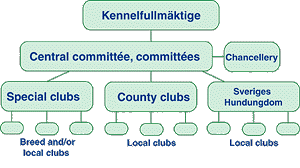 Organisation Organisation
The agility sport is now controlled by something called Svenska Brukshundsklubben, SBK -
translated that would be something like The Swedish Working Dog Club - which in turn is an
association beneath our Kennel Club, SKK. They handle not only agility but other disciplines
such as, for example, Obedience.
We also have a
national association for younger people between 7- 25 years of age called Sveriges Hundungdom,
(The Swedish Youth Dog Club). These national clubs are then divided into local clubs and since
not all of the 'adult' clubs feature agility, we have people of all ages within the youth
association.
Here in
Sweden many people find it important that 'everybody should be able to compete on equal terms'
which has led to some controversies in both obedience and agility. Should the rules favour the
extremely fast and agile shepherds? Or should accuracy and precision pay off, so that a
somewhat slower dog has a realistic chance? This discussion goes on and on and on... With the
sport starting out within the youth club, and with the high number of young people
participating, this is a serious question here.
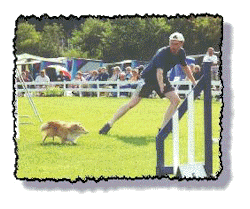 Classes Classes
Our rules and class system have just been revised, and have since this revision got
closer to both FCI and the other Nordic countries. Since 1 January 2002, we divide the
competing dogs in three different height groups:-
- Small (up to
34,99 cm)
- Medium
(35,00-42,99cm)
- Large (from
43,00 cm)
There are six
official classes: Agility 1, 2 and 3 and Hopp (=Jumpers) 1, 2 and 3, where 1 is the first and
easiest level and 3 is the most advanced. All obstacles can occur in the Agility classes, and
in Jumpers the A-frame, the dog-walk, the see-saw and the table are excluded.
Agility and
Jumpers are treated as different disciplines, and you qualify to the higher levels in Agility
and Jumpers separately. Beginners start in Class 1 Agility and Class 1 Jumpers, and to qualify
for Class 2 Agility or Jumpers you have to place 1-5 with 0 faults three times. To qualify for
class 3 Agility or Jumpers you have to place 1-3 with 0 faults three times. A consequence of
this system is, for example, that it is possible for a dog to be in class 3 Agility and class 1
Jumpers.
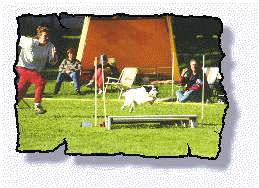 In
Class 3 Agility and Jumpers, what we call certificates can be won. To get a certificate you
need to place yourself first of all the dogs that are not already champions and also within the
first five placed. You have to make an entirely clean run (both obstacles and time). When you
have managed to win three certificates in class 3 Agility plus a show merit (or, for border
collies, a herding merit), your dog gets the title Swedish Agility Champion. Three certificates
in class 3 Jumpers, and the show or herding merit, leads to the title Swedish Agility (Hopp)
Champion. In
Class 3 Agility and Jumpers, what we call certificates can be won. To get a certificate you
need to place yourself first of all the dogs that are not already champions and also within the
first five placed. You have to make an entirely clean run (both obstacles and time). When you
have managed to win three certificates in class 3 Agility plus a show merit (or, for border
collies, a herding merit), your dog gets the title Swedish Agility Champion. Three certificates
in class 3 Jumpers, and the show or herding merit, leads to the title Swedish Agility (Hopp)
Champion.
We also have
official Team classes, where a team consists of 3 or 4 dogs, and the best three runs count.
Until 15 June 2001, the Team classes are divided in the old height groups Mini (up to 40 cm)
and Standard (over 40 cm), but from then the Team classes will follow the new height groups of
Small, Medium and Large. All dogs in a team have to belong to the same height group, and the
dogs in a team are not exchangeable.
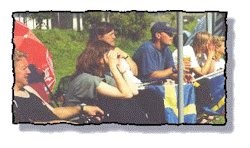 The
Swedish Championships The
Swedish Championships
The Swedish Championships – our 'Nationals' - are held in the end of August every year, hosted
by different regional branches of SBK. To qualify for the championships 2002 one needs to earn
points in class 3 Agility. This will probably change, so that both class 3 Agility and class 3
Jumpers will count.
The points are
distributed through a system of how many dogs entering the class and where you were placed. We
have a system of all these points being reported to a list and the 45 best placed Large, the 30
best placed Medium, and the 30 best placed Small dogs qualify for the championships. Also the
15 best placed teams of each height group are qualified.
At the Swedish
Championships, the individual dogs start in one Agility class and one Jumpers class the first
day. The results from these two runs are added and about half of the dogs (i.e. 20 Large, 15
Medium, 15 Small) are qualified for the finals which take place on the second day of the
Championships. In the finals everyone start from scratch and do one Agility and one Jumpers
class again. The results (faults + time) from these two runs make the final result list. The
teams only start in Jumpers, one class the first day and one class the second. The results are
added and the result list is thus construed.
The media
interest in agility (and other dog sports) is very limited here, so we envy those of you who
can watch your Nationals on TV!! We may get a feature in some local magazine if we are lucky.
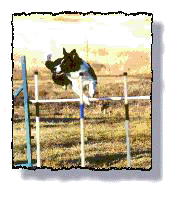 Breeds Breeds
The emphasis of agility as 'a dog sport for everyone' is displayed in the great variety of
breeds training and competing. Family dogs of every possible breed can be found in the training
classes. On the highest competitive level the most popular breed seen in the group of large
dogs here is, as in many countries, the Border Collie. We also have a great many Belgian
Shepherds, a few Australian Kelpies, mixed breeds (which are allowed to compete in our domestic
championships but not for our national team) and quite a few fast Golden Retrievers. For
example, Bengt-Göran Landin and his Golden Rockdove’s Timekeeper of Big Ben who won the Nordic
Championships in 1999.
In Small and
Medium classes one of the dominating breeds is the Shetland Sheepdog. There are also a great
many Border Terriers, Papillons and Poodles of different heights competing successfully. At
competitions, there are almost as many dogs competing in Small and Medium classes combined as
there are in Large. This is, as far as we know, quite unique for Sweden.
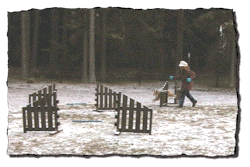 Training
opportunities Training
opportunities
Due to our climate most competitions have traditionally been held in the period April -
October. The last couple of years, however, more and more competitions have been held during
the winter. The problem is to find good indoor facilities. A few sport centres allow dogs, but
since the matter of allergies is a very big issue here we have to use riding facilities for
most of our indoor competitions. Some competitions are held at the larger indoor dog shows but
the SKK has still not quite understood agility's potential to attract spectators so they are
not always that interested in sharing their space with us.
Training in the
autumn and winter is also a problem. Some, but not all, clubs manage to rent some riding
facility for a couple of hours a week, but the possibilities to train during this time of the
year are limited. Indoor training on carpet hardly exists at all.
 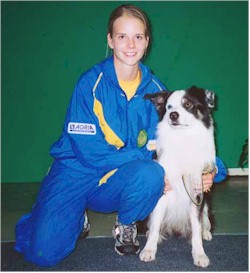 Where
do we stand? Where
do we stand?
Agility in Sweden is fairly advanced; it has been around for quite a long time and we have not
been afraid of influences from abroad. Looking at where we stand when competing in for example
the World Championships, the current World Champion in standard is the Swedish Border collie
Saltsjöborgs Lotus, owned and handled by Jenny Damm. The Swedish mini team won the bronze medal
in Porto, so it was quite a successful championship for our country. We do however have to keep
working at developing a handling that enables us to work our dogs towards that ever alluring
clean run at top speed.
Here in Sweden
there is a consensus that successive competition and fair treatment of the dog must and can go
hand in hand. Positive training and a friendly atmosphere have been important features of the
Swedish agility, and will hopefully continue to be so in the future.
About the authors

About the authors
Both Emelie Johnson and Eva Bertilsson are true agility enthusiasts, who spend
most of their spare time training, analysing, competing or teaching agility. They both have
substantial experience from other dog sports as well, but as everyone knows: agility is
addictive. The authors offer seminars in both general clicker training, clicker training for
agility, and competitive agility training.
Emelie Johnson
Vegh, who on her 'non-dog-time' is studying to become a upper secondary school teacher, has
been competing in agility for ten years. She started with her now twelve-year-old mixed breed
Vermas Lilla Nilla, who has competed in the Swedish National Championship many times and would
have had the title Swedish Agility Champion if she was not a mixed breed. Nilla has also had a
very successful career in Obedience, with all the merits for an Obedience Champion title.
In
1994 Emelie
got her first border terrier, Arracs Flox, who has been competing successfully in both Agility
(two Certificates, many times at the Swedish National Championship) and Obedience and has also
been working as a hunting dog. Both Nilla and Flox have earned medals at the Swedish
Championships team event. Both have also competed successfully at the Swedish Junior
Championships, then participating in both Agility and Obedience. 1998 it was time for a second
Border Terrier: Abullabergas Abies Excelsa – called My. My is today four years old and has
recently taken the first step towards an Agility Champion title by earning her first
Certificate. As it seems, she will qualify for this year’s Swedish National Championship.
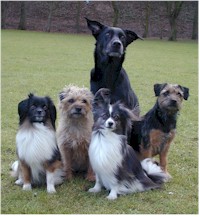 Eva Bertilsson,
student of behavioural science, has been competing in agility for eight years. At that time she
had two dogs: a Nova Scotia Duck Tolling Retriever called Sickan, and a phalène, Macrodahls
Beatrice, called Misty. Sickan earned an Obedience Champion title and competed in agility on an
intermediate level, while Misty has earned Champion titles in both Obedience, Agility and
Conformation. Misty has been one of Sweden’s most successful Mini Agility dogs the recent
years, with one gold medal (1998) and one silver medal (2001) in the Swedish National
Championship, and participation in two World Championships and three Nordic Championships.
Misty has also had two litters of pups, and her now three-and-a-half years old son Soya has
stayed in the family. Soya is on his way towards both Swedish and Norwegian Agility Champion
titles, with certificates in both countries, and there is also a good chance that he will
qualify to this year’s Swedish National Championship. Eva Bertilsson,
student of behavioural science, has been competing in agility for eight years. At that time she
had two dogs: a Nova Scotia Duck Tolling Retriever called Sickan, and a phalène, Macrodahls
Beatrice, called Misty. Sickan earned an Obedience Champion title and competed in agility on an
intermediate level, while Misty has earned Champion titles in both Obedience, Agility and
Conformation. Misty has been one of Sweden’s most successful Mini Agility dogs the recent
years, with one gold medal (1998) and one silver medal (2001) in the Swedish National
Championship, and participation in two World Championships and three Nordic Championships.
Misty has also had two litters of pups, and her now three-and-a-half years old son Soya has
stayed in the family. Soya is on his way towards both Swedish and Norwegian Agility Champion
titles, with certificates in both countries, and there is also a good chance that he will
qualify to this year’s Swedish National Championship.
Photo credits: Thanks to
Anna & Nalle for giving permission to use the photos from their site
http://w1.438.telia.com/~u43800024/index.htm
Feedback
From
Kirsten Kosinski
Interesting
to learn about our sport in other countries - that is also why I check into Agiltynet from time
to time! (27/03/02)
|